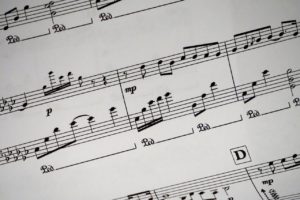
Read this article in 4 levels: Basic A1 (英検3級), Intermediate B1(英検2級), Advanced C1(英検1級), original version. Multiple choice content questions for each level. Free English reading practice. The more you read in English, the more your English will improve. Today, let’s read about when and why people started writing music down.
A1 Beginner 英検3級
B1 Intermediate 英検2級
C1 Advanced 英検1級
Original article
A1 Level Beginner
When did people start writing music down?
Long ago, people started to write music. They began in a time called the 6th century BC. But the way we write music now started in the 11th century.
Music is very old. We don’t know when it started. People like to sing and dance. This is natural for us. A long time ago, people made music too. The oldest music things we found are very, very old, from 42,000 years ago. They are flutes made from bird bones and big elephant teeth. There is also a very old flute made from a bear’s bone. It is even older, from 60,000 years ago. People think it was used for music.
In the past, people made simple music things like flutes and drums. The first thing with strings for music was called a lyre. It was made in two old places called Mesopotamia and Egypt. At first, people used music for important times, not just for fun.
In a place called ancient Greece, music was very important. People used music for many things, not just special times. They even started to study music. This was a new idea. They wrote about music, but not like we do now.
Much later, in the 11th century, people in the church made a new way to write music. This helped people sing together. A man named Guido made it better. He used lines to show how high or low to sing. Now, we can write any music so anyone can sing or play it.
Questions
1. When did people start writing music down?
– A) In the 1800s
– B) In the 20th century
– C) When they invented computers
– D) In the 6th century BC
2. What is one of the oldest music things we found?
– A) A flute made from bird bones
– B) A guitar
– C) A piano
– D) A computer
3. How old is the very old flute made from a bear’s bone?
– A) 100 years old
– B) 1,000 years old
– C) 60,000 years old
– D) 5 years old
4. What was the first thing with strings for music?
– A) A drum
– B) A piano
– C) A computer
– D) A lyre
5. Why did people use music at first?
– A) For cooking
– B) For important times
– C) For playing games
– D) For sleeping
6. Where was music very important?
– A) In ancient Greece
– B) On the moon
– C) In modern cities
– D) Underwater
7. Who made the new way to write music better?
– A) A king
– B) A computer
– C) A teacher
– D) A man named Guido
8. What did the new way to write music help people do?
– A) Play video games
– B) Cook better
– C) Sing together
– D) Sleep
Answers 1D 2A 3C 4D 5B 6A 7D 8C
B1 Level Intermediate
When did people start writing music down?
People have been making music for a very long time. They first started writing music down in the 6th century BC, but the way we write music today began in the 11th century. We don’t really know when people first started making music because it’s something that comes naturally to us, like talking and moving. The oldest musical instruments we’ve found are about 42,000 to 43,000 years old. These are flutes made from bird bones and mammoth ivory. There’s even an older flute made from a bear’s thighbone, dated to about 60,000 years ago, which shows that even Neanderthals made music.
In the beginning, people made simple instruments like wind instruments and drums. The first stringed instrument was the lyre, created in Mesopotamia and Egypt. Music was often used for religious reasons at first, not just for enjoyment. But in ancient Greece, music became a big part of life. It wasn’t just for religion or dancing; it was also used in poetry, theaters, and festivals. The Greeks even started studying music theory in the 6th century BC. They wrote down music in a basic way, using notes and phrases to show how to sing songs.
The way we write music now started in the 11th century with Gregorian Chants in the church. These chants had notes called neumes, which showed how to sing them. But it was hard to follow if you hadn’t heard the music before. A monk named Guido of Arrezo came up with a solution by drawing four lines and placing symbols on them to show the pitch of the music. This made it easier for anyone to sing or play music, even if they hadn’t heard it before. This is how music notation began.
Questions
1. When did people first start writing music down?
– A) In the 20th century
– B) In the 6th century BC
– C) In the 1800s
– D) In the 11th century
2. How old are the oldest musical instruments found?
– A) 10,000 years old
– B) 5,000 years old
– C) 20,000 years old
– D) Between 42,000 and 43,000 years old
3. What were the first musical instruments made from?
– A) Plastic
– B) Stone
– C) Metal
– D) Bird bones and mammoth ivory
4. In ancient Greece, music was used for all of the following EXCEPT:
– A) Cooking
– B) Dancing
– C) Religion
– D) Festivals
5. Who began the study of music theory?
– A) The Romans
– B) The Greeks
– C) The Egyptians
– D) The Mesopotamians
6. What is Gregorian Chant associated with?
– A) Schools
– B) The church
– C) The government
– D) Theaters
7. Who invented the system of music notation we use today?
– A) Aristotle
– B) Pythagoras
– C) Guido of Arrezo
– D) Pope Gregory I
8. What was the main problem with the early method of writing music?
– A) It was too colorful
– B) It was written in a foreign language
– C) It was too simple
– D) It was hard to follow if you hadn’t heard the music before
Answers 1B 2D 3A 4C 5B 6B 7C 8A
C1 Level Advanced
When did people start writing music down?
The genesis of musical notation is a fascinating journey that traces back to the 6th century BC, though the contemporary system that is ubiquitously employed today wasn’t established until the 11th century.
The inception of music itself predates recorded history, rendering its exact origins indiscernible. However, it is intrinsically linked to human nature, acting as an innate extension of speech and movement, likely echoing through the annals of early human existence. The discovery of the oldest known musical instruments, flutes fashioned from bird bones and mammoth ivory, dating back between 42,000 and 43,000 years, alongside a Neanderthal flute crafted from a bear’s thighbone estimated at 60,000 years old, provides concrete evidence of music’s antiquity and its presence in both Neanderthal and Homo sapiens cultures.
Over millennia, musical instruments have evolved from the rudimentary wind instruments and drums, valued for their simplicity and ease of creation, to the sophisticated stringed instruments, such as the lyre in Mesopotamia and ancient Egypt. Initially, music served religious purposes, with the concept of documenting music as abstract as the idea of writing down stories before the advent of written language. This paradigm shifted with the ancient Greeks, who not only integrated music deeply into their societal fabric—utilizing it for a plethora of activities beyond mere religious ceremonies and dances—but also pioneered the study of music theory in the 6th century BC.
Greek interest in music extended to its theoretical aspects, with figures like Pythagoras delving into its mathematical underpinnings. While early attempts at musical notation by the Greeks sought to outline melodic execution rather than transcribe music in the contemporary sense, it laid the groundwork for future advancements. The survival of 52 Greek musical compositions, albeit in varying conditions, underscores the historical attempt to capture music, despite the lack of consensus on their precise interpretation today.
The advent of the modern musical notation system is rooted in the 11th century, attributed to the Gregorian Chants within the Roman Catholic Church. Unlike the direct transcription of music, the notation initially comprised neumes to guide the vocal rendition of liturgies. The inherent ambiguity of neumes, however, presented significant challenges in maintaining melodic uniformity.
The resolution to this quandary was innovated by Guido of Arezzo, who introduced a system of four horizontal lines to indicate pitch, revolutionizing the notation by providing a clear, interpretable guide to musical performance. This innovation laid the foundation for the nuanced and comprehensive system of music notation that enables the replication and dissemination of musical compositions across disparate cultures and epochs.
Questions
1. When was the contemporary system of musical notation that we use today established?
– A) In the Roman era
– B) In the 11th century
– C) During the Renaissance
– D) In the 20th century
2. Which culture’s musical instruments provide the earliest concrete evidence of music’s presence in human history?
– A) Roman
– B) Neanderthal and Homo sapiens
– C) Egyptian
– D) Mesopotamian
3. The study of music theory was initiated by which civilization?
– A) Ancient Greeks
– B) Ancient Egyptians
– C) The Mesopotamians
– D) The Romans
4. What was the primary purpose of music in its earliest forms?
– A) Entertainment
– B) Communication
– C) Religious ceremonies
– D) Education
5. Who is credited with innovating the notation system that allowed for a clear indication of pitch?
– A) Pythagoras
– B) Aristoxenos
– C) Pope Gregory I
– D) Guido of Arezzo
6. What challenge did the early method of using neumes in musical notation face?
– A) It was too complex
– B) It lacked aesthetic appeal
– C) Difficulty in maintaining melodic uniformity
– D) It was restricted to vocal music
7. The oldest known musical instruments, dating back between 42,000 and 43,000 years, were made from what materials?
– A) Wood and stone
– B) Gold and silver
– C) Iron and bronze
– D) Bird bones and mammoth ivory
8. The integration of music into ancient Greek society was for purposes beyond what activities?
– A) Religious ceremonies
– B) Communication
– C) Diverse societal activities
– D) Warfare
Answers 1B 2B 3A 4D 5D 6C 7A 8C
Original Article
When did people start writing music down?
When did people start writing music down? Music was first written down in the 6th century BC, but the current system we use began in the 11th century.
There is no way of knowing when music itself started. It is very natural for us to sing and dance because they are merely extensions of talking and moving. It most probably was natural for early humans as well. The earliest human musical instruments found have been carbon dated between 42,000 and 43,000 years ago. They are flutes made from bird bones and the ivory from a mammoth. There is a Neanderthal flute that has been found and dated to 60,000 years ago. It is made from the thighbone of a bear. The holes are definitely not accidental and its purpose was probably music, although that obviously cannot be known for definite. This shows that Neanderthals had music as well. Both Neanderthals and homo sapiens probably used music in social occasions and maybe in religious occasions as well.
Musical instruments evolved over the millennia. Wind instruments and drums were the first because they are the simplest and they don’t have any moving parts. They are very easy to make. Rattles were easy to make as well. The first stringed instrument was the lyre, made in Mesopotamia and then in Ancient Egypt. Early music was for the purpose of religion and not just music for the sake of music. There was no concept that music could be written down, just as there was no concept that stories could be written down before writing was invented. All of this changed with the Ancient Greeks.
Music was everywhere in ancient Greece and it was a huge part of the culture. It was far more than just for dancing and for religion. It was used for the performing of poetry (early songs), in theaters, festivals, weddings, and many other occasions. However, the Greeks went one step further than just playing the instruments, they began music theory. The study of music began in roughly the 6th century BC and a document written by Aristoxenos in the 4th century BC is the first surviving example of music theory. Greeks were very interested in it. Pythagoras, the famous mathematician, was fascinated with music and he believed that it was a mathematical expression of the cosmic order. The music theory of the 4th century used a writing system that is the first attempt to write down music. However, they didn’t write it down in the way that we do. They used notes and phrases to explain how the songs should be sung and accompanied. There are 52 pieces of Greek music that survive in various states. Experts have tried to play these, but there is no consensus on what they should actually sound like.
The modern system of musical notation that we use today has its origins in the 11th century with the Gregorian Chants that were used in church. In the Roman Catholic church, the liturgy was often sung. A liturgy is a public worshipping ritual, where everybody repeats the same text. It was almost like the poems set to music that the Ancient Greeks used. These liturgies were reorganized by the 64th pope, Pope Gregory I in 720ish. He was canonized after he died and Gregorian chants are named after him. Gregorian chants were carried around the Catholic world and people made notes on them so they knew how they should be sung. These notes were called neumes, and they weren’t writing down the music, rather they were writing down how the chants should be sung. The neumes marked rising or sinking pitch and other things that would be needed when singing, such as a long note or a tremor. The problem was, it was not easy to sing the chants if you didn’t know what the music was, and it was very difficult to keep everyone singing the same tune.
A monk called Guido of Arrezo saw this problem and he came up with a novel solution. He drew four horizontal lines over the words in the chant. He decided on the key of the chant and he drew a red line that was on that note, C for example, then he drew the other symbols above or below that line to show whether the singer should go up in pitch or down in pitch. The genius of having four lines he could place the symbols on showed the singer just how much they should go up or down in pitch. The shape of the notes changed over time from the original squares to round notes. Some of the symbols disappeared and new ones appeared. The number of lines went from four to five, but Guido of Arrezo had invented music notation. With his system, any music could be written down for anyone to sing or play, whether they had heard it or not.
Questions
1. When was the first known instance of music being written down?
– A) 11th century
– B) 20th century
– C) 6th century BC
– D) 1st century AD
2. Which of the following materials were used to create some of the earliest known musical instruments?
– A) Metal and wood
– B) Bird bones and mammoth ivory
– C) Plastic and rubber
– D) Stone and clay
3. How old is the Neanderthal flute made from a bear’s thighbone?
– A) 30,000 years ago
– B) 42,000 years ago
– C) 60,000 years ago
– D) 10,000 years ago
4. Where was the first stringed instrument, the lyre, created?
– A) Mesopotamia and Ancient Egypt
– B) Ancient Greece
– C) The Roman Empire
– D) The Indus Valley
5. Who was fascinated with music and believed it was a mathematical expression of the cosmic order?
– A) Aristoxenos
– B) Pythagoras
– C) Guido of Arrezo
– D) Pope Gregory I
6. What did the notes called “neumes” in Gregorian Chants indicate?
– A) The rhythm of the music
– B) The instruments to be used
– C) How the chants should be sung
– D) The lyrics of the chants
7. Who invented the modern system of music notation with horizontal lines and symbols?
– A) Aristoxenos
– B) Pythagoras
– C) Pope Gregory I
– D) Guido of Arrezo
8. What main problem did Guido of Arrezo’s music notation system solve?
– A) It introduced musical instruments to the world
– B) It made music easier to transport
– C) It allowed music to be written down for anyone to sing or play
– D) It standardized musical genres
Answers 1C 2B 3D 4A 5B 6C 7D 8C
Image Photo by Pixabay: https://www.pexels.com/photo/music-sheet-showing-musical-notes-534283/
Article https://ilearnedthistoday.com/index.php/2024/03/18/when-did-people-start-writing-music-down/




Leave a Reply